Contents
Controlled transport and manipulation of stored light
Controlled manipulation, storage, and retrieval of quantum information is essential for quantum communication and computing. Quantum memories with light stored in cold atomic samples has already been realized in many platforms. However, transporting the stored light gives further control and opens news doors in quantum information processing. In this regard, we have successfully transported stored light over distances comparable to the atomic cloud (storage medium) dimensions, which can be found in our paper. For light storage we employed ground state EIT in cold Rb atoms, which maps the light pulse into a light-matter quasi-particle known as Dark-state polariton. Equipped with the optical conveyor belt (discussed below) we transported the stored pulse over macroscopic distances and retrieved the light pulse. We are further working towards achieving a multi-segmented system for light storage and controlled manipulation of the stored light which will set the groundwork for realizing novel quantum devices such as optical racetrack memories or optical quantum registers.
Strong interactions inside hollow-core fiber
Typically, photons in vacuum do not interact with each other. However, if passing through an appropriate non-linear medium, photons can interact with each other. This opens many exciting possibilities for creating strongly correlated non-classical states of light or using photonic systems as quantum simulators. In our approach, we used a cloud of laser-cooled atoms in a quasi-one-dimensional geometry to create these photon-photon interactions.
Experimental techniques
- We used a hollow core photonic crystal fiber to guide both light field and atoms. This allows for transporting atoms throughthe fiber and creates a tight quasi one-dimensional confinement for the atoms inside the fiber.
- We employed a coherent two-photon EIT process (see below) to achieve strong nonlinearity to get strong effective photon-photon interactions.
- Additionally, for strong long-range atom-atom interactions for additional non-local effects. To do this, we can excite our atoms to highly excited states, the so-called Rydberg states. They have an enormous polarizability so that dipole-dipole interactions between atoms play a role.
Long distance guiding in hollow core fibers

With the advent of laser cooling techniques, atoms are readily cooled down to temperatures low enough to start showing their quantum behavior. This opens up a whole new area of physics based on quantum mechanics which offers tremendous increase in measurement accuracy, e.g. in gravitation sensing or in atomic clocks. However, these atoms are so sensitive to the environment that maneuvering is not an easy task. In this project, we establish techniques for guiding atoms for long distances maintaining their coherence properties. We transport our atom cloud with the help of an optical conveyor belt. It consists of two counter propagating laser beams which form a standing wave. The atoms are trapped in the dipolar field of this beam and are transported by changing the relative detuning between the two beams. The controlled transport and optimal loading of the atomic cloud into the fiber has been discussed in details in arXiv:1805.06333 (2018). The hollow core fiber carrying a Gaussian mode of light also keeps the atoms tightly confined in the center of the fiber to reduce any surface effects. The guiding distance is mainly limited by the fiber length and should scale favorably compared to free space implementations. The Gaussian mode of the guided light has the advantage of good overlap with the atoms, thus enhancing the light-matter interaction.
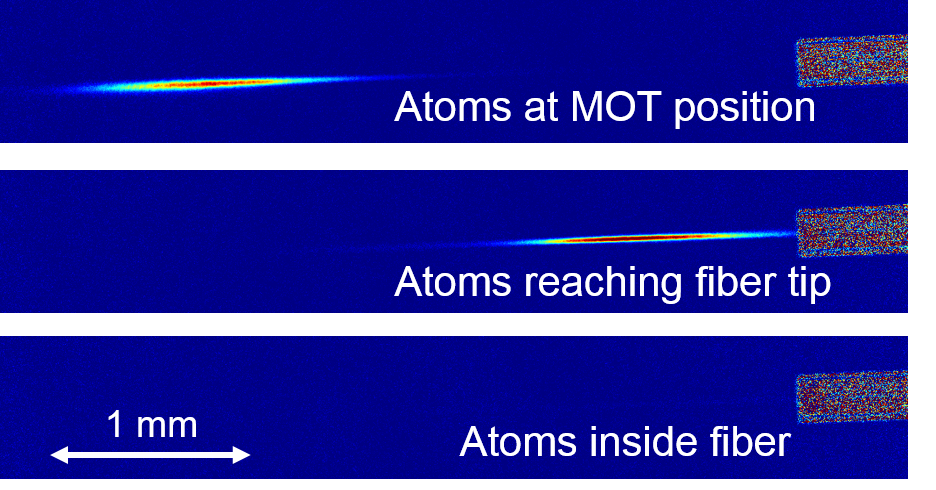
Strongly interacting systems
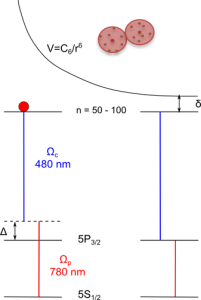
As discussed above, interactions between photons are possible in the presence of certain non-linear media, which could be specially designed crystals, cold atoms, etc. In our experimental setup, photons and atoms can both stay confined in the fiber throughout its entire length and hence there is a strong enhancement in the interaction between them. Under certain conditions, this system can offer a strong non-linearity, which is highly controllable. One possibility is electro-magnetically induced transparency (EIT), a coherent two-photon process which renders an otherwise absorptive medium transparent in the presence of an additional control light beam.
In addition, long-range interactions between atoms can introduce correlations between non-local photons. This can help in realizing transfer of quantum information from one photon to the other one mediated via atoms. Because of their strong dipole moment, one of the most promising candidates for such a task would be Rydberg atoms. Their dipole interaction is so strong that within a blockade radius, only one Rydberg atom can be excited (see image 3). Relatively long lifetimes at higher quantum numbers makes Rydberg atoms even more suitable for studies of non-linear phenomena using ladder-type EIT. A typical two-photon EIT scheme is sketched below. Summing all up, EIT with tightly confined Rydberg atoms in a hollow core fiber offers long-range interactions between photons. We have successfully demonstrated the feasibility of exciting cold Rydberg atoms inside a hollow-core kagome fiber and we studied the influence of the fiber on Rydberg electromagnetically induced transparency (EIT) signals as shown in our paper (PRA 96, 041402(R) (2017)).
Furthermore, EIT can also be employed to “store” light pulses into the atomic medium. By switching the control beam on and off in a controlled manner the probe beam can basically be stored in the atomic ensemble. We used ground state EIT in D2 transition in Rb in our recent experiment on light storage.
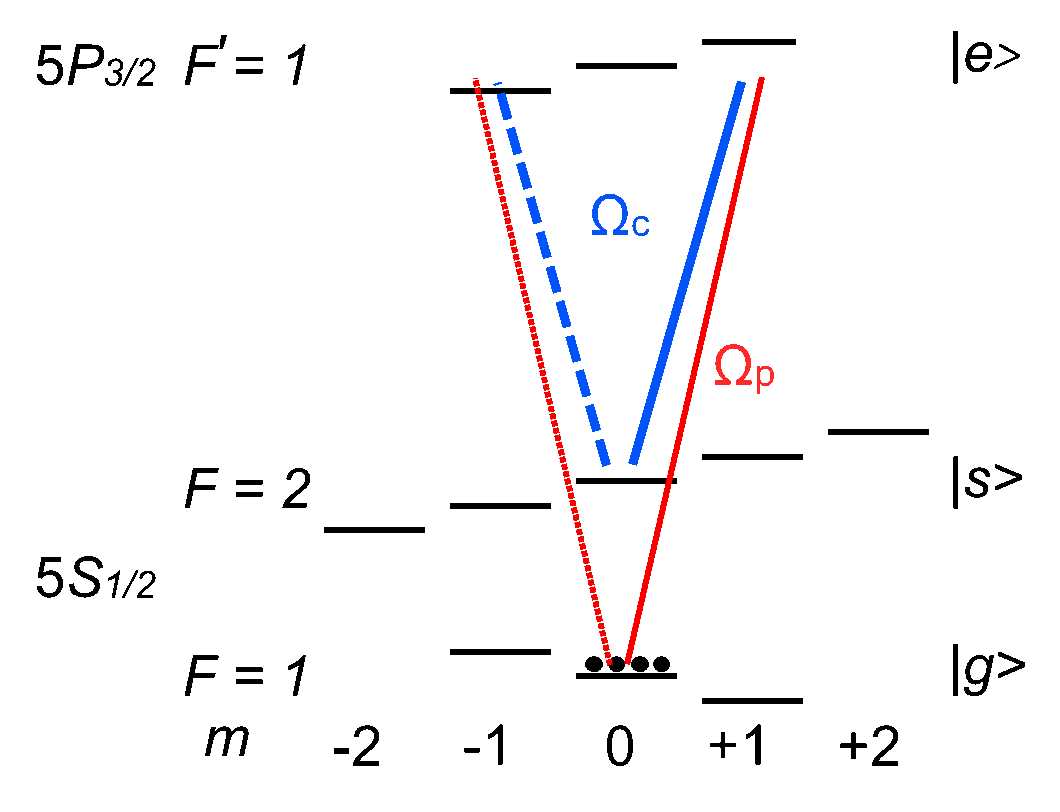
Experimental Setup

In our experiment, we use a 2D – 3D MOT setup to trap and laser cool Rb-87 atoms. The atoms are first precooled in a 2D MOT and are then transported to the main experimental region, which is a custom-made vacuum chamber. There, they are trapped again in the 3D MOT and cooled down to temperatures of a few µK.
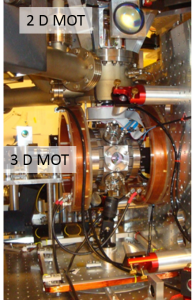
In the picture below, you can see the Rubidium 3D MOT inside the vacuum chamber, right in front of our hollow core fiber. The fiber itself is mounted horizontally on a special vacuum-compatible fiber mount. On the right hand side of the MOT, you can see one lens inside the vacuum chamber, which we use to couple light fields into the hollow core fiber. The broadband properties of our fiber makes it suitable to guide different wavelengths.
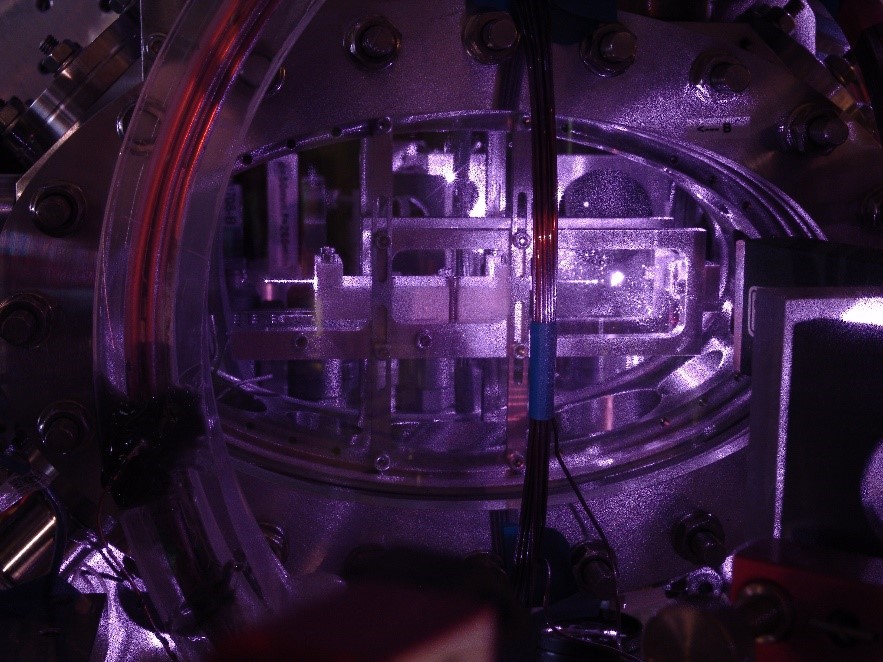
For example, we use a laser beam, which is red-detuned relative to the atomic transition to create a dipole trap for the atoms, which guides them into the fiber. We are also using a multi-color laser system to excite the atoms into the Rydberg states.
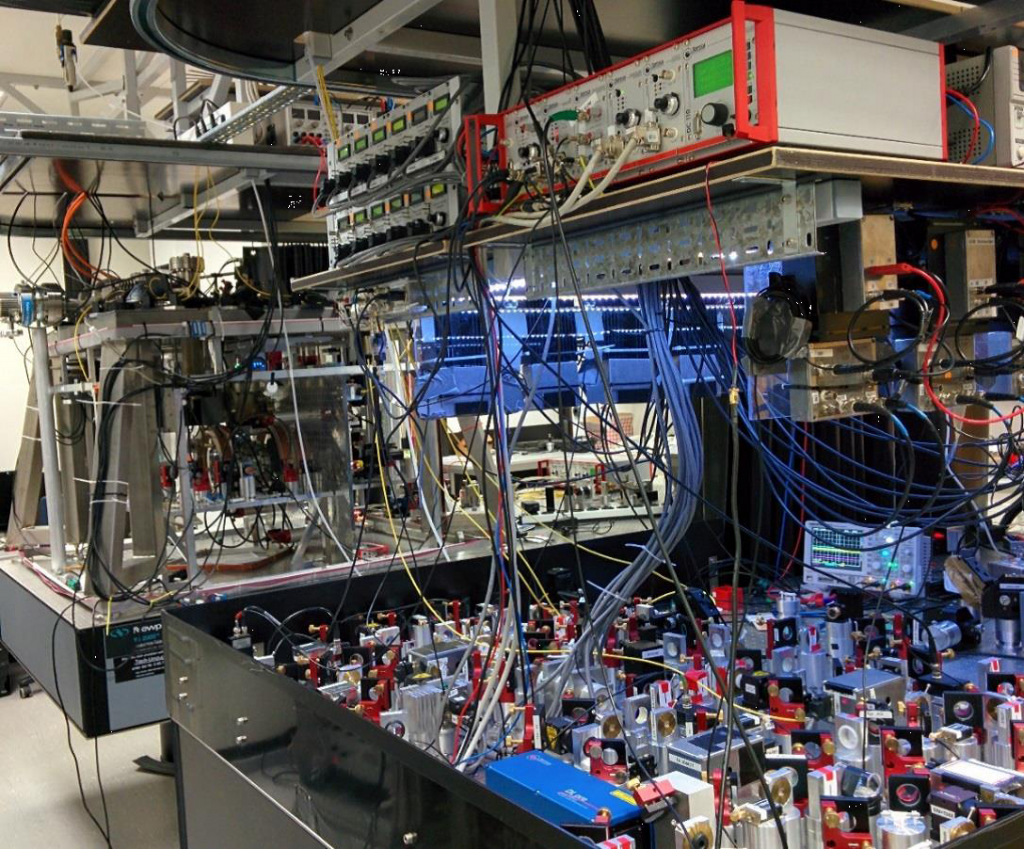
Previously, our experimental apparatus was located in Hamburg, where many experiments including the first demonstration of guiding cold Rubidium atoms through a 88 mm long hollow core photonic band gap fiber (S Vorrath et al 2010 New J. Phys. 12 123015) were performed in the group of Prof. Klaus Sengstock.
Open Positions - Bachelor / Master Theses
 We always have projects both for bachelor and master theses available. Currently we have the following projects to offer:
We always have projects both for bachelor and master theses available. Currently we have the following projects to offer:
- AOM Characterization: for a multichannel dipole trap
- A new dipole trap: assembling a TA for a crossed dipole trap.
If you are interested in joining our team as a bachelor or master student, please contact Prof. Patrick Windpassinger or the PhD students.
Past Theses
A highly controllable cold Rydberg atom hollow-core fiber interface, Maria Langbecker (2020)
Strong light-matter interaction in confined geometries, Mohammad Noaman (2019)
Optischer Transport von kalten Atomen in eine Hohlkernfaser, master thesis by Ronja Wirtz (2018)
Rydbergspektroskopie in Hohlkernfasern, master thesis by Chantal Voss (2017)
Programmierung und Implementierung einer flexiblen AOM-Ansteuerung, bachelor thesis by Florian Stuhlmann (2016)
Rubidium spectroscopy inside hollow core fibers, bachelor thesis by Maik Selch (2016)
Stabilitätsuntersuchungen eines Zweistrahl-Laserinterferometers, bachelor thesis by Christian Korn (2016)
EIT-Spektroskopie von Rydbergzuständen an Rubidium, bachelor thesis by Chantal Voss (2015)
Publications
Controlled transport of stored light
Wei Li, Parvez Islam, Patrick Windpassinger (2020)
Kalte Atome auf einem optischen Förderband
Maria Langbecker & Patrick Windpassinger
Physik in unserer Zeit 50, 10 (2019)
Micro lensing induced lineshapes in a single mode cold-atom hollow-core fiber interface
Mohammad Noaman, Maria Langbecker, Patrick Windpassinger
Opt. Lett. 43(16), 3925-3928 (2018), arXiv:1805.11391
Highly controlled optical transport of cold atoms into a hollow-core fiber
Maria Langbecker, Ronja Wirtz, Fabian Knoch, Mohammad Noaman, Thomas Speck, Patrick Windpassinger
New J. Phys. 20 083038 (2018)
Rydberg excitation of cold atoms inside a hollow-core fiber
Maria Langbecker, Mohammad Noaman, Niels Kjærgaard, Fetah Benabid, and Patrick Windpassinger
Physical Review A 96, 041402(R) (2017)
Efficient guiding of cold atoms through a photonic band gap fiber
S. Vorrath, S. A. Möller, P. Windpassinger, K. Bongs, K. Sengstock
New J. Phys. 12 123015 (2010)
